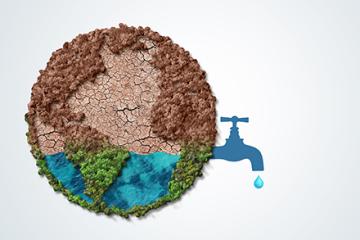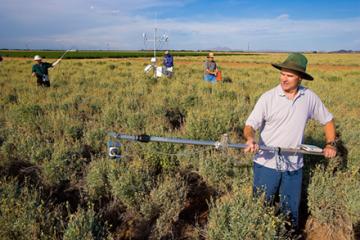Water Vision 2050

Image courtesy of Getty Images.
USDA, ARS Scientists Chart Course of Water Management
As much water as there is in the world, only about one-half of 1% of it is drinkable. To illustrate, if the world’s water supply was condensed to 26 gallons (about 100 liters), fresh water would amount to only one-half of a teaspoon. What’s worse, that half-teaspoon appears to be leaking.
The Agricultural Research Service (ARS) is leading a team of over 40 scientists to identify and formulate a plan to address the most significant challenges to the world’s water resources and agricultural production by the year 2050.
Water Vision 2050 takes aim at the greatest threats to water availability and sustainable agriculture, including climate change and the increasing global population, and puts forward recommendations for critical research and water management actions.
The three ARS project leaders are Teferi Tsegaye, national program leader for water availability and watershed management; Cathleen Hapeman, research chemist; and Emile Elias, hydrologist and director of the USDA Southwest Climate Hub in Las Cruces, NM. Tsegaye and Hapeman both work in Beltsville, MD.
“Climate change is altering precipitation patterns and increasing air and water temperatures globally, which disrupts agricultural production,” said Tsegaye. “These changes are causing more intense drought and heat waves, even as heavier downpours and flooding occur more frequently. At the same time, growing populations are competing for water that is traditionally used by agriculture.”
According to Elias, these events create complex consequences for water availability, quality, and distribution, especially when combined with other biophysical and ecological stressors, changing economic conditions, and the values and expectations of society.
“National, regional, and local solutions to these challenges are complex,” she said. “They must include climate, soil characteristics and management, agricultural practices, food systems, agroenvironmental programs and policies, and the role of water in local cultures and economies.”
One major case in point concerns the Ogallala Aquifer, one of the world’s largest underground freshwater sources. The aquifer underlies 175,000 square miles in eight states, and its water irrigates about 30% of the nation’s agriculture. There are concerns that the aquifer could be depleted by the end of the century.

Doug Hunsaker, ARS agricultural engineer, collects remote-sensing data to monitor soil-water depletion and improve irrigation scheduling efficiency. (Photo by Stephen Ausmus, D1298-1)
ARS has supported research on the issue through the Ogallala Aquifer Program for nearly 20 years, partnering with other institutions and USDA agencies.
“We have made major strides as a nation in understanding and limiting water waste in urban settings, especially in the American West,” Hapeman said. “Many people now understand the measures they can take to reduce water use and many municipalities have strong, active water conservation programs.”
While it varies across the nation, more than 70% of total freshwater use is for agriculture in many parts of the West.
“We are conducting research to use wastewater for supplemental irrigation to help reduce the effects of short-term dry spells,” Hapeman explained. “We are also using crop growth models and climate data to discover when supplemental irrigation would help, and how much yield could be recovered using this technique. The next step is to determine what infrastructure it would take to be economically feasible.”
Additional research includes breeding crops that require less water to grow and climate-controlled farming. ARS is even searching for ways for water to do double duty. For example, in aquaponics, fish are grown in a tank and then its naturally fertilized water irrigates crops in a hydroponic environment.
“The perspectives outlined in Water Vision 2050 represent a deep understanding of the water-agriculture nexus and the needs for both food and water security,” Tsegaye said.” We’ve taken a holistic approach, recognizing the interconnected nature of water in supporting resilient ecosystems, communities, and individuals.”
“The most compelling thing about this project is that it signals a new, collaborative way to address our most critical water resource-related issues and challenges,” Elias said. “Climate change and population growth are formidable challenges, but scientists and citizens are hopeful through action.” – By Scott Elliott, ARS Office of Communications
You May Also Like:

